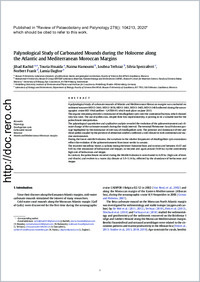Palynological study of carbonated mounds during the holocene along the atlantic and mediterranean moroccan margins
- Rachid, Jihad Hassan II University, Laboratory dynamics of sedimentary basins and geological correlations, Faculty of Sciences Ben M'Sick Casablanca, Morocco
- Hssaida, Touria Hassan II University, Laboratory dynamics of sedimentary basins and geological correlations, Faculty of Sciences Ben M'Sick Casablanca, Morocco
- Hamoumi, Naima Mohammed V University, Research Group ODYSSEE Laboratory Materials, Nanotechnology and Environment (LMNE), Research Center for Materials Science, Faculty of Sciences Rabat, Morocco
- Terhzaz, Loubna Mohammed V University, Research Group ODYSSEE Laboratory Materials, Nanotechnology and Environment (LMNE), Research Center for Materials Science, Faculty of Sciences Rabat, Morocco
- Spezzaferri, Silvia University of Fribourg, Dpt. Geosciences, B.1700 Fribourg, Switzerland
- Frank, Norbert Heidelberg University, Institute of Environmental Physics and Institute for Geosciences, Heidelberg, Braden-Württemberg, Germany
- Daghor, Lamia Laboratory of Ecology and Environment, Department of Biology, Faculty of Sciences Ben M'sik, Hassan II University of Casablanca, B.P. 7955, Sidi Othmane, Casablanca, Morocco
-
01.07.2020
Published in:
- Review of Palaeobotany and Palynology. - 2020, vol. 278, p. 104213
English
A palynological study of carbonate mounds of Atlantic and Mediterranean Moroccan margins was conducted on sediment boxcores MD13-3441, MD13-3456, MD13-3461, MD13-3465, MD13-3468 collected during the oceanographic cruise MD 194/Eurofleet - GATEWAY, which took place on June 2013.The organic remaining revealed a dominance of dinoflagellate cysts over the continental fraction, which showed very low rates. The use of pollen data, despite their low representativity, is proving to be a valuable tool for the paleoclimate interpretation.The palynological quantitative and qualitative analysis revealed the evolution of the paleoenvironment and climate change of the carbonate mounds during this study interval. The terminal Pleistocene– basal Holocene passage highlighted by the dominance of cold taxa of dinoflagellate cysts. The presence and dominance of tree and shrub pollen coupled by the presence of altitudinal conifers confirmed a cold climate in both continental and marine environments.During the lower-middle Holocene, the variations in the relative frequencies of dinoflagellate cyst associations reflect the evolution of the paleoenvironment from inner neritic to oceanic.The recorded microflora shows a cyclicity during the lower Holocene from arid to semi-arid between 10.07 and 9.85 ka (the abundance of herbaceous and steppe), to become arid again around (9.69 ka) by the consistently high rate of herbaceous and steppe.In contrast, the paleoclimate recorded during the Middle Holocene is semi-humid to 6.29 ka (high rate of trees and shrubs) and evolves to a warm dry climate at 5.9–5.14 ka, reflected by the abundance of herbaceous and steppe.
- Faculty
- Faculté des sciences et de médecine
- Department
- Département de Géosciences
- Language
-
- English
- Classification
- Geology
- License
- License undefined
- Identifiers
-
- RERO DOC 328637
- DOI 10.1016/j.revpalbo.2020.104213
- Persistent URL
- https://folia.unifr.ch/unifr/documents/308729
Statistics
Document views: 119
File downloads:
- spe_psc.pdf: 277
